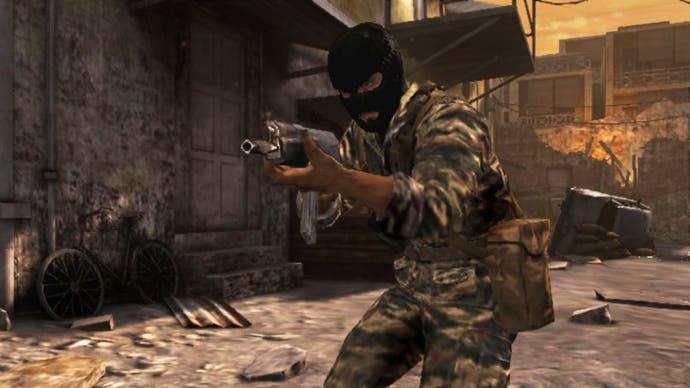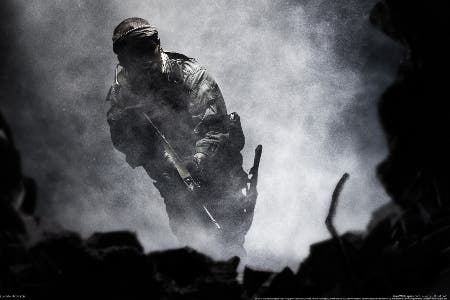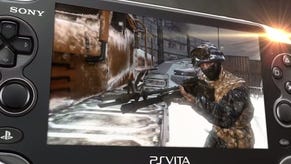Call of Duty: Black Ops Declassified review
Plops.
Black Ops Declassified is a Call of Duty game minus the spectacle. And for a series that has placed almost all of its energy into developing spectacle over the past few years - the snowmobile leaps over famished ravines, the horseback charges into tank fortresses, the collapse of the Eiffel Tower - this leaves us with something of a flaccid anachronism, one that exposes the tired heart beneath the bluster.
Of course, for some, the set-piece has destroyed the first-person shooter in recent years: an invasion of Hollywood showmanship that has robbed soldiering games of their flexibility and tactical breadth in favour of a tightly controlled pyrotechnical show. But while Black Ops Declassified casts out the set-piece (or, more truthfully, hasn't the budget to pay for it), the game maintains the underlying Call of Duty format: a series of unyielding play corridors that must be trudged through en route to the mission's exit - an exit that isn't punctuated by nuclear explosions or toppling landmarks.
Nevertheless, it would be dishonest for any critic to breathlessly praise its heavyweight PC and console brother, Black Ops 2, for its vainglory before gasping in indignation at this handheld expansion to the fiction. Black Ops Declassified may be short, it may be devoid of spectacle, it may be missing that spark of creative life force that keeps the annual routine of Call of Duty games from truly stagnating - but the two games undeniably share a soul and a structure.
Developer Nihilistic has ably replicated the feel of Call of Duty. You move through the game's pocked streets with familiar quickness and precision, the Vita's stiff, pleasing analogue sticks allowing you to wheel around and pick out targets on a dime or to line up squinting headshots in a pinch. The left trigger brings up the iron-sights of whichever of the scores of weapons you've plundered from the trail of dead, while a tap of the right fires a shot. A squeeze empties the magazine. So far, so FPS.

Swipe at the front touchscreen and you'll slash a knife upwards, melee-killing any enemy within arm's length, while stabbing at the grenade icon on the HUD will lob the projectile down your line of sight, driving a huddle of enemies from cover or decimating an unsuspecting room. Approach a closed door and you must plant a pack of C4, breach and clear the room as the splinters and bodies drop in slow motion. At every turn, your Call of Duty muscle-memory remains unchallenged: Black Ops Declassified is a functionally convincing expression of Infinity Ward's ageing template, at least at the most basic level.
However, zoom out and the game's wider problems shift uncomfortably into focus - problems covered in the frantic fingerprints of a team straining against time and budget. Black Ops Declassified is billed as a segue between the events of the two main Black Ops titles, placing you in the jackboots of Frank Woods and Alex Mason. Nobody cares about this story, or about these clichés of sweat and balls who bark nonsense such as “All kinds of shit here; intel everywhere” when crashing through an operations room or “We hit the f***ing hornet's nest” as the next line of identikit enemy soldiers file in through some side-door.
But the plot usually provides some justification for a tour of exotic theatres of war (and in the case of Captain Price and John MacTavish, a welcome seasoning of real character). In Declassified, you'd be hard pressed to tell Vietnam from Russia from West Berlin; the dull concrete of military locations offer little distinction aside from the weather. Likewise, it's never quite clear whose idiot boots you're filling, nor indeed why you're being ferried from one corridor to the next.
Not only disjointed, the 10 stages in the single-player campaign are also woefully short, an issue the developer sidesteps by eliminating checkpoints. This has a profound effect on the way that you play. Each time you're overcome by the enemy you must start the mission again from the very beginning. The immediate sting of disbelief at this choice soon makes way for other feelings. The raised stakes inspire caution, so rather than blasting your way into each room, you pad carefully, checking lines of sight, listening for the shuffle and shift of a lurking murderer. It feels closer to an arcade game than a modern FPS, with all the exhilaration and frustration that entails.
"Nobody cares about this story, or about these clichés of sweat and balls who bark nonsense."

Scraps of content - and this really is content rather than craft - surround the main campaign: Time Trial versions of the main missions and Hostiles, a see-how-long-you-can-last take on Gears of War's Horde mode. Online, the game presents a tight range of 4-vs.-4 modes including Free-For-All, Kill Confirmed, Team Deathmatch and Dropzone. Unfortunately, securing matches is a lottery - all too often you'll wait 5 minutes on a loading screen only to be deposited back into the main menu. When you do make it into a match, the small levels exhibit little of the flow and feel of the mainline games, something no amount of Care Packages, Challenges, Create-a-Class, Killstreaks and Perks in the superstructure framework can fix.
Some of these failings must be laid at the developer's door; Nihilistic's execution lacks flair and, worse, care. The protracted loading times (which appear to extend the longer you play the game in a single sitting) as well as online connectivity problems are technical, while the absence of set-pieces is an issue of time or budget.
But Declassified also exposes failings of Call of Duty's form and fashion. The game is a cliché, its thrills limited, its time-stretching ploys clear. It's infused with the character of Call of Duty, but stripped of the spectacle it reveals the underlying game to be wholly plain and an uninteresting use of your time.




